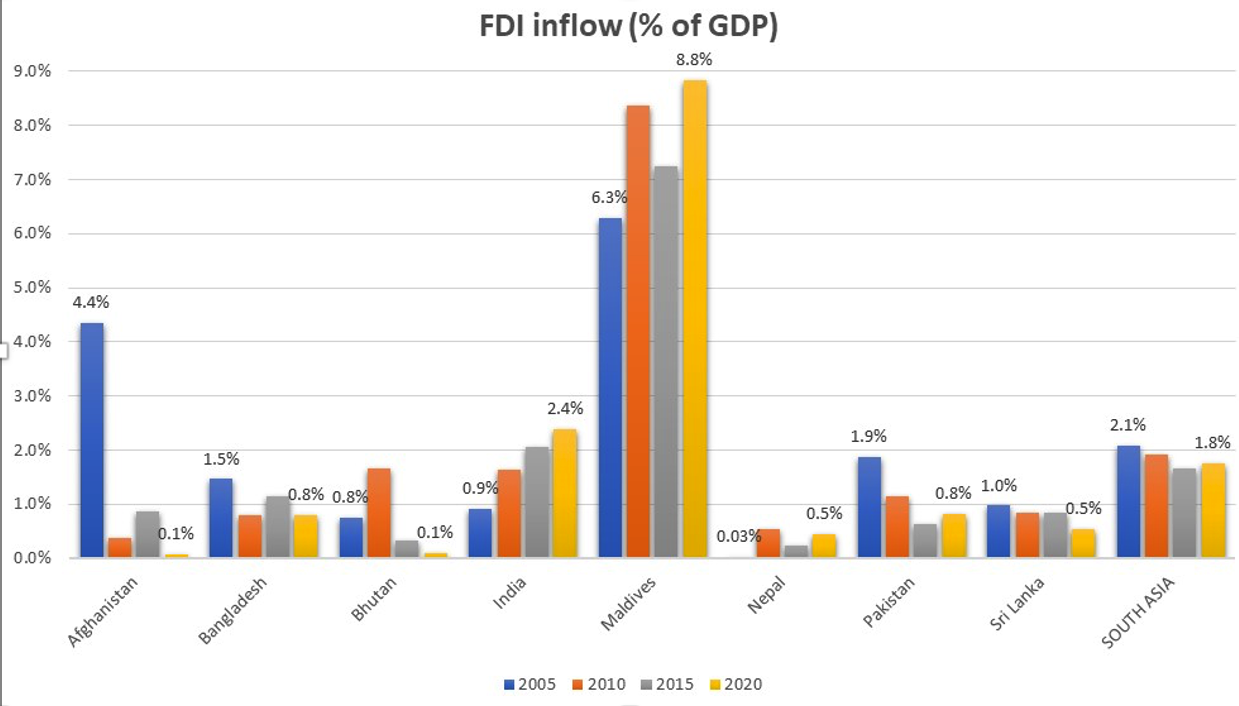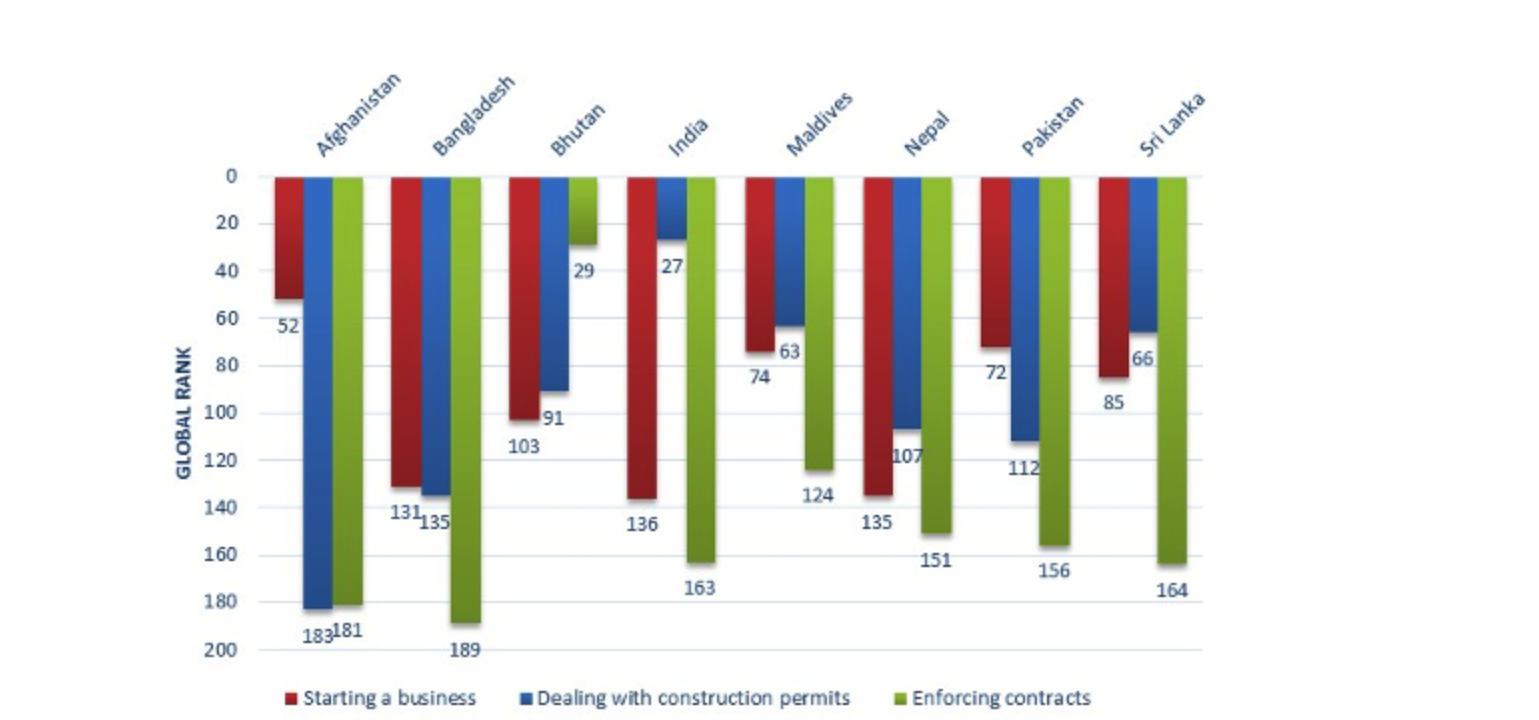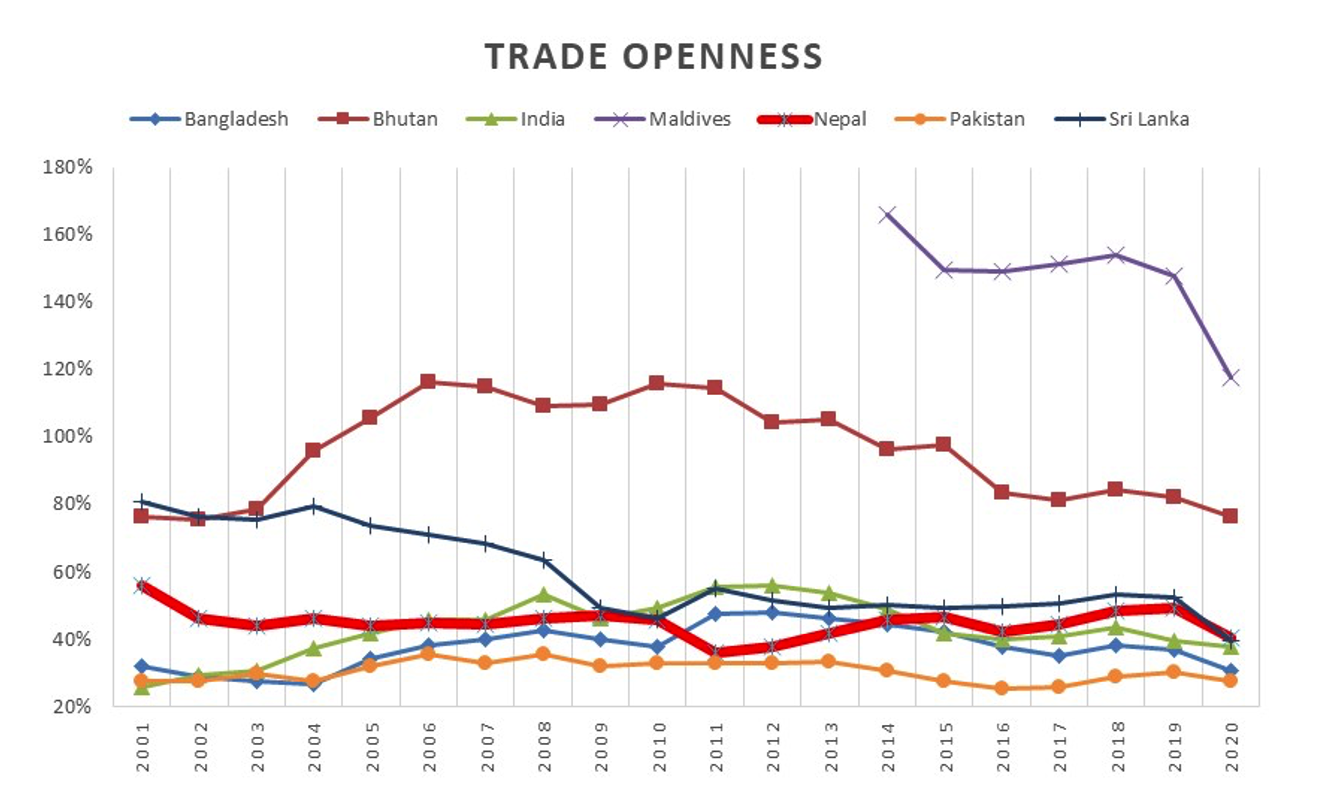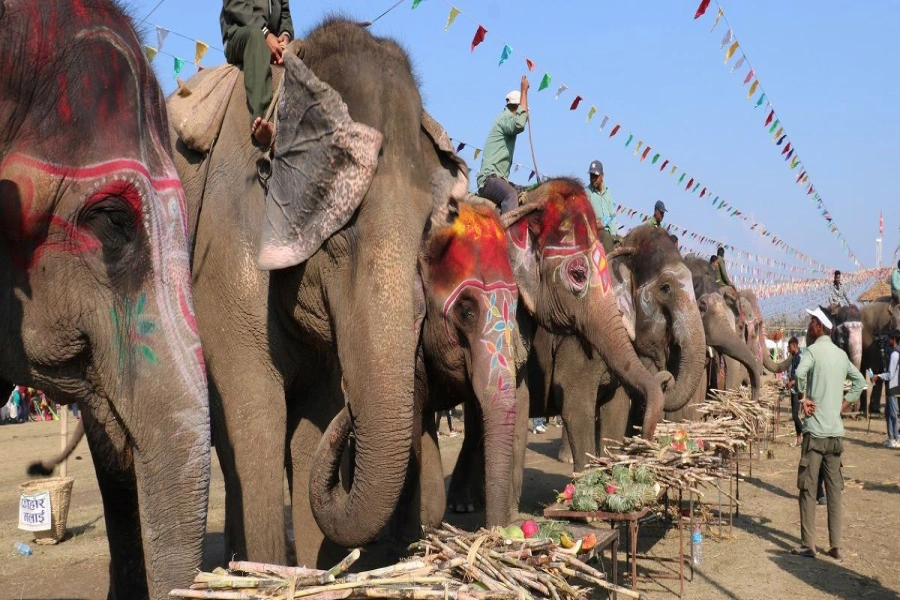One province clearly captures a disproportionate share of FDI flowing into the country
FDI brings not only capital into a country, but also transfers knowledge and technology from the sender to the recipient country. China benefited immensely from these. To some extent, this has happened in India and Bangladesh, but not so much in Nepal because Nepal’s FDI landscape is littered with issues that hurt the flow of FDI and the associated knowledge and technology transfers.
In 2020, Foreign Direct Investment (FDI) flow to South Asia increased by 21%. This was surprising, considering developing economies around the world saw 8.4% decline that year. Nepal’s FDI inflow in 2020 was 0.5% of the GDP, which pales in comparison to 8.8% in the Maldives and 2.4% in India. The regional average was 1.8%. Nepal’s statistics do not get better even when we look back to 2015, 2010, or 2005. While Nepal saw over 49% increase in FDI inflow in 2020, we have always had the poorest performance in the region (excluding Afghanistan).
Source: World Bank
FDI brings not only capital into a country, but also transfers knowledge and technology from the sender to the recipient country. China benefited immensely from these. To some extent, this has happened in India and Bangladesh, but not so much in Nepal because Nepal’s FDI landscape is littered with issues that hurt the flow of FDI and the associated knowledge and technology transfers. I wish to highlight three such issues: diversification of flow, FDI realization, and policy red tape.
Diversification issues
Much of Nepal’s FDI inflow in 2020 went into three sectors: manufacturing, mining, and quarrying (28.3%), electricity, gas, and water (27.5%), and financial intermediation (27.3%). When over 83% of the total FDI inflow goes into three sectors, it leaves the rest of the economy gasping for investment support. We have a clear FDI inflow sectoral diversification issue.
Are these three sectors attracting more FDI because they are more productive and utilize FDI better? Data does not support this. Nepal’s manufacturing output actually declined by over 12% in 2020. Manufacturing’s capacity utilization in 2020 was 44% (it was 54% in 2019) i.e., the manufacturing sector’s output was 44% of its potential.
What about locational diversification? In 2020, 60.5% of FDI ended up in Bagmati Province, followed by 15.3% in Gandaki, and 12.9% in Province 1 (Koshi Province).
Therefore, the sector that attracted the most FDI inflow in 2020 had low capacity to utilize additional capital infusion, and the sector’s output shrank despite the FDI infusion. Also, one province clearly captures a disproportionate share of FDI flowing into the country.
The serious lack of sectoral and locational FDI diversification can mean one of two things: either other industries/provinces in Nepal are inept/incapable of presenting a strong case for themselves as investment vehicles/destinations, or there is a government policy fracture that must be studied and fixed.
Take holistic measures to boost FDI in Nepal

I believe it is both. More investments must go to capital-deficient sectors and provinces. More investments must go to promising sectors, like IT and tourism.
FDI realization issues
In the aftermath of the 2015 earthquakes, Nepal received huge reconstruction aid commitments from countries around the world. Many donors reneged on their promises, and Nepal never received many of those committed funds. This happens with FDI commitments, too. For example, in the 1995-2020 period, Nepal’s FDI realization (actualization of the commitments) was only 34% i.e., only 34% of committed investments actually materialized.
Nepal’s FDI realization rate must improve. While much of this process is private-enterprise driven, the government can help with better policies, policy stability, lobbying, and strategic support to investors. For example, many countries provide tax relief and other support to foreign investors who commit large investments. India and Bangladesh do this. Do we?
Red tape issues
Sometimes, FDI commitments get withdrawn not due to investor disinterest, but due to frustrations with red tape and bureaucracy. According to the World Bank’s Doing Business reports, this is a regional problem in South Asia.
In 2020, starting a business was difficult in India (ranked 136), Nepal (135), and Bangladesh (131). Obtaining Foreign investors often require construction permits to set up shop in South Asia, but obtaining such permits was difficult in Bangladesh (ranked 135), Pakistan (112), and Nepal (107). South Asia’s contract enforcement ranking is even worse, suggesting it takes Herculean efforts to enforce contracts in the region. This kind of performance does not inspire investor confidence.
Source: World Bank
In Nepal, we remain stubbornly rooted to maintaining an obnoxiously inefficient system. For example, FDI investment application for less than NPR 2 billion must be submitted to the Department of Industry and be approved by its director general. FDI investment applications between NPR 2 billion and NPR 10 billion must be submitted to the Department of Industry, and must be approved by the Industrial Promotion Board. FDI investment application for more than NPR 10 billion must be submitted to and be approved by the Investment Board Nepal.
Why do we have one agency accepting applications and another agency approving them? Why do we differentiate foreign investments by how much money is being brought in?
What if there is a foreign entity that wants to invest in four different projects: micro, small, medium, and large? Does the government of Nepal want that investor running around to six different government agencies filing applications and seeking approvals? Is NPR 10 billion so much more important than NPR 9.9 billion to warrant less hassle?
Does nobody in the Nepal government realize that this kind of cockamamie policy regime is insulting to foreign investors?
With such half-cooked policies, no wonder FDI commitments to Nepal shrank last year. Nepal needs a one-window policy that does not discriminate foreign investments by their sizes.
Nepal also needs a better policy focus. I can think of three areas we can focus on: economic freedom, openness, and competitive taxation.
Greater economic freedom
Greater economic freedom translates to greater FDI inflow. Certain components of economic freedom—rule of law, market openness, and facilitative regulatory environment—are more impactful in attracting FDI. While South Asian neighbors made progress in economic freedom rankings in past decades, Nepal continues to struggle (Nepalis had the least economic freedom in 2020). FDI growth does not happen in a vacuum, and labor is a critical input for economic output. If labor is not free, FDI inflow is affected.
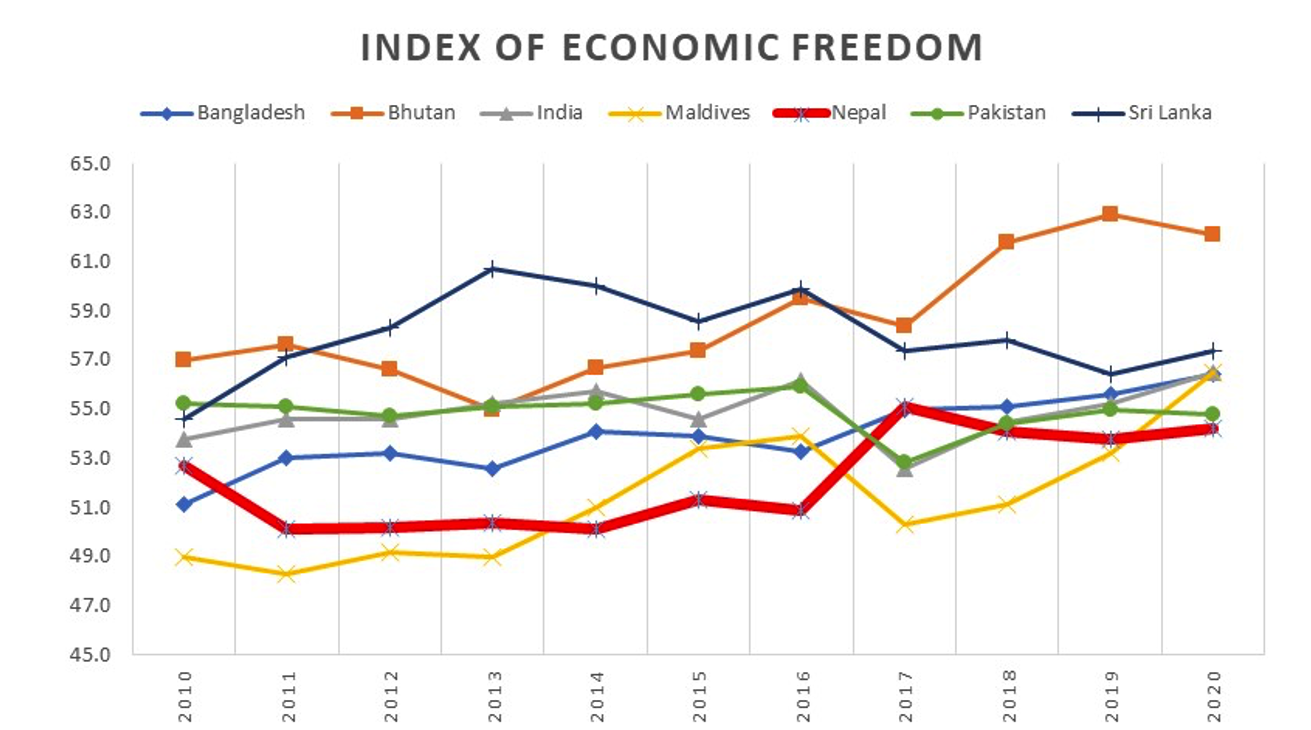
Source: The Heritage Foundation
More open economy
Smaller economies often fear that opening themselves up to greater trade openness may cause capital outflow, and economic growth may suffer if that capital outflow reduces exports. However, studies show this is a short-term phenomenon. Greater openness is net positive for FDI inflow in the long run. Today’s FDI flow is also impacted by FDI shocks from the past, suggesting it is important to embrace greater openness sooner rather than later.
Nepal’s economy opened itself in the 1990s, coming in the heels of India opening itself to foreign investments. Greater openness has benefitted South Asia, and India and Bangladesh today are fast-growing economies as a result. While many Nepalis deride globalization, Nepal’s economy and people have fared better after embracing openness. Our economy has grown, incomes have increased, health and education have improved, and living standards have improved.
However, we still lag behind our South Asian and global friends. Within South Asia, Nepal was in the middle of the pack in 2020 on trade openness. This hurts our FDI aspirations.
Source: World Bank
Competitive Tax Regime
Studies show there exists a tradeoff between FDI inflow and tax rates, with tax elasticity close to or over -1. That means, a one percentage point increase in corporate tax rate reduces FDI inflow by at least one percentage point. The size of this directional effect may vary between countries and provinces and industries, but the general consensus in research is that an increase in tax reduces FDI inflow. Studies also show that corporate tax rate competitiveness is a determining factor for FDI locational decisions for multinational firms.
These findings tell us that lowering taxes, such as the corporate tax rate, is a strategy that countries embrace to increase FDI inflows. In today’s world, where capital moves quickly and easily from one corner of the world to another, countries must be tax competitive not only to attract more FDI but to stop the outflow of domestic capital as well.
Does Nepal have a competitive tax regime that facilitates FDI attraction? Between 2010 and 2020, several countries in South Asia (India, Sri Lanka, Pakistan, Bangladesh) lowered their corporate tax rates, but Nepal’s tax rate remained unchanged. That is, while several of our neighbors were becoming more tax competitive to attract FDI, we showed no effort.
We must do more.
Source: World Bank



